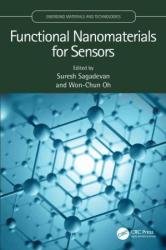Functional Nanomaterials for Sensors
- Добавил: literator
- Дата: 25-02-2023, 10:07
- Комментариев: 0
 Название: Functional Nanomaterials for Sensors
Название: Functional Nanomaterials for SensorsАвтор: Suresh Sagadevan, Won-Chun Oh
Издательство: CRC Press
Год: 2023
Страниц: 338
Язык: английский
Формат: pdf (true)
Размер: 16.7 MB
Because of their novel chemical and physical properties, functional nanomaterials have found increasing industrial applications in nanoelectronics, energy science, and biological applications. Functional Nanomaterials for Sensors surveys advances in functional nanomaterials and their use in sensing. It covers their properties, synthesis, design, fabrication, and their applications, including in chemical, biological, and gas sensing, environmental remediation, fuel cells, catalysis, electronic devices, and biotechnology.
Recently, with the improvement of human quality of life, many efforts are being made to live healthy, pleasant, and comfortable lives. Sensors are one of the essential factors for improving the quality of life, and high-performance intelligent sensors are required, so demand for them is expected to increase further in the future. Recently, functional materials that give functions to sensors are becoming more important. In particular, nanofunctional materials existing in various components and forms are attracting more attention because they have unique physical, chemical, mechanical, and optical properties differentiated from existing bulk materials. Recently, research on nanotubes including carbon nanotubes (CNTs) and nanocomposites has been very active to be further developed in existing nanoparticle research and applied as sensors. This book examines the latest nanosensor research and development (R&D) trends such as gas sensors, water quality sensors, biosensors, light sensors, and physical sensors, and it is predicted that high functionality and miniaturization of sensors by nanomaterials will be used as a very important part.
Research on nanosensors using nanomaterials such as metals, inorganic, organic, biological, and composite materials having a shape of less than or equal to 100 nm in various compositions and forms such as nanoparticles, nanowires, and nanotubes has been actively reported. This is due to the unique physical, chemical, mechanical, and optical properties of nanomaterials. For example, when a nanosensing material having a large specific surface area is used in a gas sensor, a low concentration air pollution source may be detected even at a low operating temperature, thereby lowering power consumption and ultimately miniaturizing a sensor, and thus, a material having a very large specific surface area such as nanoparticles, nanowires, and graphene has been used. This book describes two points. The first point is about how to manufacture nanostructured materials such as nanoparticles and nanowires, and the second point is about the latest nanosensor technology trends using nanomaterials. In fact, many nanosensor research results using nanomaterials are being published, so the contents covered in this book will be part of them, and it can be used as a reference for researchers and developers who want to conduct related research and development.
Trends in sensor R&D technology using various nanomaterials were described. Although the vast amount of research worldwide deals with only a few research cases, nanomaterials are developed in various ways in the form of nanoparticles, nanowires, nanotubes, and nanocomposites, and it is confirmed that they are expanding to various applications such as gas sensors, water sensors, biosensors, light sensors, and physical sensors. From this, furthermore, it can be predicted that future state-of-the-art sensor technologies will act as more essential factors for high functionality and miniaturization of nanomaterials. However, sensors using nanowires have the advantage of being able to manufacture nanowires of a wide variety of compositions and structures compared to the top-down method, but more research is needed on the technology for assembling and aligning nanowires in two dimensions as in the top-down method. In addition, although research has already been conducted at advanced research institutes in various countries, research on the stability of ultrafine nanomaterials—such as toxicity to the human body and the environment—is expected to develop into a technology that can be sustainable for R&D and industrialization.
Electronic devices are equipment that governs the passage of electrical currents in order to process data and control systems. Transistors and diodes are two prominent examples. Electronic devices are typically tiny and can be packaged together into integrated circuits. Semiconductor materials are used in the majority of modern electronic gadgets. Nanoelectronics improve electrical device capabilities, boost memory chip density, and reduce power consumption and transistor size in integrated circuits. In electronics, nanotechnology allows for faster, smaller, and more portable devices. Nanoelectronics improves electrical device capabilities, boosts memory chip density, and reduces power consumption and transistor size in integrated circuits. These nanomaterials are used in nanotechnology in various fields such as industry, medical, energy transportation, electronics, information technology, polymers, environmental science and many more.
Features:
• Describes how nanomaterial functionalization is being used to create more effective sensors
• Discusses various synthesis procedures, characterization techniques, and which nanomaterials should be used for sensing applications
• Provides an in-depth look into oxide nanostructures, carbon nanostructures, and two-dimensional (2D) material fabrication
• Explores the challenges of using nanoscale sensors for large-scale industrial applications
This book is aimed at materials, chemical, biotech, and electronics researchers and industry professionals working on sensor design and development.
Скачать Functional Nanomaterials for Sensors
Внимание
Уважаемый посетитель, Вы зашли на сайт как незарегистрированный пользователь.
Мы рекомендуем Вам зарегистрироваться либо войти на сайт под своим именем.
Уважаемый посетитель, Вы зашли на сайт как незарегистрированный пользователь.
Мы рекомендуем Вам зарегистрироваться либо войти на сайт под своим именем.
Информация
Посетители, находящиеся в группе Гости, не могут оставлять комментарии к данной публикации.
Посетители, находящиеся в группе Гости, не могут оставлять комментарии к данной публикации.
